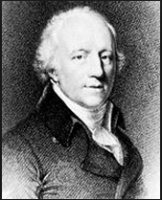










Richard Lovell Edgeworth was an Anglo-Irish politician, writer and inventor.
Biography
Edgeworth was born in Pierrepont Street, Bath, England, great-grandson of Sir Salathiel Lovell through his granddaughter, Jane Lovell.
A Trinity College, Dublin and Oxford alumnus, he is credited for creating, among other inventions, a machine to measure the size of a plot of land. He also made strides in the developing educational methods. He anticipated the caterpillar track with an invention that he played around with for forty years but that he never successfully developed.He described it as a "cart that carries its own road".
He married Frances Beaufort, older sister of Francis Beaufort of the Royal Navy. The two men installed a telegraph line for Ireland.
Richard Lovell Edgeworth was a member of the Lunar Society. The Lunar Society evolved through various degrees of organization over a period of years, but was only ever an informal group. No constitution, minutes, publications or membership lists survive from any period, and evidence of its existence and activities is found only in the correspondence and notes of those associated with it. Dates given for the society range from sometime before 1760 to it still operating as late as 1813.
Fourteen individuals have been identified as having verifiably attended Lunar Society meetings regularly over a long period during its most productive time: these are Matthew Boulton, Erasmus Darwin, Thomas Day, Richard Lovell Edgeworth, Samuel Galton, Jr., James Keir, Joseph Priestley, William Small, Jonathan Stokes, James Watt, Josiah Wedgwood, John Whitehurst and William Withering.
Richard Edgeworth and his family lived in Ireland at his estate at Edgeworthstown, County Longford, where he reclaimed bogs and improved roads. He sat in Grattan's Parliament for St Johnstown (County Longford) from 1798 until the Act of Union in 1801, and advocated Catholic Emancipation and parliamentary reform. He was a founder-member of the Royal Irish Academy. He died in Edgworthstown on 13 June 1817.
Family
He was the father of Maria Edgeworth, Michael Pakenham Edgeworth, and 20 other children (by his four wives), and grandfather to Francis Ysidro Edgeworth.
By his first wife Anna Maria Elers Edgeworth had four children: Richard (1765–1796), died in America; Maria the novelist; Emmeline, married to J. King of Clifton; and Anna Maria, married to Dr. Thomas Beddoes.
By his second wife Honora Sneyd he had Lovell, who inherited the property, and Honora, a beauty, who died in 1790.
By his third wife Elizabeth Sneyd, he had five sons and four daughters, of whom Charles Sneyd (d. 1864) succeeded his brother Lovell, and Honora married Francis Beaufort in 1838; William Edgeworth was known as an engineer.
By his fourth wife Frances Ann Beaufort,daughter of Daniel Augustus Beaufort and Esther Gougeon, he had four children, including Michael Pakenham Edgeworth, who became a botanist. Their son Francis Beaufort Edgeworth was mentioned in Thomas Carlyle's Life of Sterling. He married a Spanish lady, Rosa Florentina Eroles, and their son Antonio Eroles Edgeworth succeeded his uncle Charles Sneyd at Edgeworthstown. Their second son Francis Ysidro Edgeworth became an influential economist.A daughter Lucy Jane married the Irish astronomer Thomas Romney Robinson.